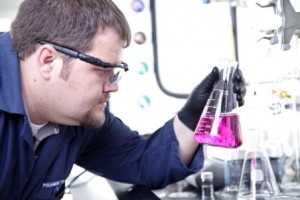“The true method of knowledge is experiment.” William Blake said that. Who would have thought that an 18th Century British poet could so perfectly state a fundamental premise of materials testing? Method development is integral to everything we do here at Polymer Solutions, and helps ensure the experiments we do to test the safety and efficacy of materials will produce valid, reliable results.
It’s important to understand the difference between method development and method validation. Method development is the process by which we defi ne how to get a result from a test. Method validation is a series of tests to demonstrate how well we can reproduce a result.
ne how to get a result from a test. Method validation is a series of tests to demonstrate how well we can reproduce a result.
We begin method development as soon as we receive a material for testing, and learn from the clients what they want to know about the material. Method development typically incorporates known testing processes — those that are commonly used to test a given material — and a healthy dose of educated predictions from an experienced scientist. The aim of method development is to define what steps are necessary to get a specific analytical result.
In order to do this, we need to define what parameters are necessary to identify and possibly quantify an unknown for a material. That unknown could be virtually anything, from the molecular weight and composition of the material to how it’s likely to function in a given application.
For example, to identify a plasticizer in a soft plastic, the process of method development would require several steps. First, we would need to decide the type of sample we’ll work with. Then, we must consider how we’ll extract the plasticizers from the material so we can further evaluate them. We also need to know how we’ll separate the plasticizers, identify exactly what type they are, and determine the quantity present in the material. The analysis parameters could encompass the temperature of the material at the start of the test, how quickly we’ll increase the temperature, and many more details.
We may start our analysis with a general idea of the testing methods we need to use, but to optimize our results, we need to evaluate different parameters and tailor our methods accordingly. Sometimes, a few simple tweaks are all that’s needed. Other times, we may need to try various techniques to determine the best methods.
Method validation demonstrates that our methods are going to be able to reliably reproduce the desired test results. It involves running the methods we developed many times, with at least two technicians, to define how accurate our methods really are. This helps us understand how reliable, consistent and accurate our test results are likely to be, and the level of risk associated with our methods.
Method development and method validation are important for regulatory compliance, whether we’re doing medical device testing to help a client achieve FDA compliance or testing a material used in industrial manufacturing to ensure it meets regulations for worker and consumer safety. When we establish a relationship with a client at the beginning of a material’s lifecycle, the method development we conduct in those early stages of the relationship means that subsequent tests will be more cost-effective and efficient moving forward.
